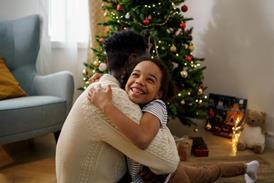
Here is an intergenerational Christmas experience, which can be used for a special event, as part of an intergenerational service or a Messy Church. In fact, it can be adapted for a wide range of contexts, so think about where it might be best to use the ideas in your Christmas programme. We’ve brought together ideas and methodologies from across the magazine to create a Premier Childrenswork Christmas. Let us know what you think and how you used the material!
The experience is made up of eight stations, eight parts of the story which participants can experience in intergenerational groups. To stage the whole journey you’ll need a large space such as a church building or hall. A venue that has lots of nooks and crannies would work well (such as an old church building), as it would enable all the stations to take place in the same room.
Create intergenerational groups by combining a couple of family groups, or mixing couples, single people, a family and older people. Remember, this is not just a family event, but one that welcomes all of your church community and beyond. Set the different stations around the space you have available, making sure that you leave enough room between each station so they don’t disturb each other. At the start of the journey, create a starting and ending area: set out chairs and tables to create a café and serve drinks and snacks (such as mulled wine, hot chocolate, tea and coffee, together with mince pies, Christmas cake and other seasonal treats).
Once everyone is gathered together in their groups, set each group off at five minute intervals. As people are waiting to set off (or waiting while others finish), have some low-key activities around the café for the groups to do. These could be simple crafts, questions to discuss, table-top games – whatever suits the groups, your situation and the resources you have available.
The stations
Each station should have copies of the relevant Bible text available, from an accessible translation, such as the GNB or CEV. You might also choose to have children’s Bible storybooks available. Have a facilitator at each station to help the group start on the activity.
1 Mary and the angel: Luke 1:26–38
You will need: small wrapped presents (something that everyone will appreciate, such as small chocolate bars or bags of sweets) each with the question ‘What are you looking forward to this Christmas?’ included inside
This is a time to acknowledge the anticipation of Christmas. Open the presents and answer the question all together. Share some of the excitement and anxiety that Christmas can bring. Read the story of Mary and Gabriel (from Luke 1:26–38) and chat about whether Mary might be looking forward to the birth or anxious about it. Enjoy eating your presents together!
2 Joseph and his dream: Matthew 1:18–24
You will need: a large candle (or electric storm lantern), plenty of blankets, info card from www.premierchildrenswork.com (this should be in a darker part of the building, if possible, to give the impression of night)
Gather round the candle and sit under the blankets together. Encourage one person in the group to read out the card, then spend some time reflecting on Joseph’s story.
Think about a time in the last week or so when things haven’t gone your way.
[Pause to let people reflect.]
Joseph was engaged to Mary, but when he heard about her baby, he decided that he couldn’t marry her. But, rather than shame her in public, he was going to break off the engagement privately. Imagine how Joseph must have felt.
But God had other plans for Joseph! God sent an angel in a dream to reassure Joseph. Things wouldn’t be easy for Joseph and Mary, but that God was in control.
Sometimes it’s hard to see what God is doing and everything can seem in ruins. God doesn’t promise that everything will be easy, but he is in control. What do you want to say to him about that?
3 Journey to Bethlehem: Luke 2:1–4
You will need: a simple labyrinth marked out on the floor (search online for examples of labyrinths), a bell
Read out the Bible passage and then set people off walking slowly around the labyrinth. Every 20 seconds, ring the bell. Everyone should pause and think about a journey they have been on. Where were their coming from? Where were they going to? This could be a literal or metaphorical journey. Ring the bell three or four times. On the final ring, ask people to think about how Joseph and Mary were feeling on their journey.
4 Birth of Jesus: Luke 2:5–7
You will need: party food (whatever you can provide), drinks, party poppers, hats etc, a nativity set laid out in the middle of the food table, Luke 2:5–7 written attractively on card
At the halfway stage of the journey, pause and hold a party to celebrate Jesus being born! Put on hats, share food and ask each other what Christmas means to you. Finish the time by looking at the nativity scene and reading the Bible verses.
5 Shepherds and angels: Luke 2:8–21
You will need: angel and / or sheep template from Premier Childrenswork website, art and craft materials (if you’re making sheep, include items such as cotton wool), the questions below written on card
Make lots of copies of the angel and / or sheep template and provide as many art and craft materials as you can. Everyone should make a Christmas decoration. While people work, they should ask each other these questions:
• What good news have you received recently?
• How did you tell everyone?
• What would you have done if you were one of the shepherds?

6 Simeon and Anna: Luke 2:22–32; 36–38
You will need: balloons, marker pens
Encourage one person to read Luke 2:22–32 and another to read verses 36–38. Wonder for a moment why the two people were so happy and thankful for Jesus. Is anyone in the group thankful for Jesus?
Have fun blowing up the balloons together. Members of the group should help each other and also should be aware of anyone in their group who doesn’t like balloons, or is scared of them popping. Everyone should write on the balloon something they are thankful for (help anyone who struggles to write). Then throw the balloons up in the air – every time you hit a balloon, shout whatever is written on it.
7 Wise men: Matthew 2:1–12
You will need: gold chocolate coins, frankincense oil, myrrh oil, two incense burners (optional), card from Childrenswork website
Read Matthew 2:1–12 together. Share out the gold coins and eat them together. One person in the group should read out the ‘gold’ section of the card. If you can, make crowns out of the gold foil wrappers.
Then pass round the frankincense oil for people to smell, or if you have incense burners, light the one with frankincense oil in it. (You could also put a small amount of oil on a clean handkerchief, if you’re concerned about spilling the oil.) Another person in the group should read out the ‘frankincense’ section of the card. Finally pass round the myrrh oil for people to smell, or if you have incense burners, light the one with myrrh oil in it. (Again you could just use some oil on a clean handkerchief.) A third person in the group should read out the ‘myrrh’ section of the card. Allow a moment for the group to reflect on these three items.
Gold was for a king. Jesus was born to be king of God’s people, of the whole world. But he wasn’t the kind of king God’s people were waiting for.
Frankincense was used by priests in the temple. Jesus was going to help us draw close to God and worship him in new and dramatic way.
Myrrh was sometimes used to put on dead bodies. Jesus’ death was going to be as important as his birth. At Christmas we celebrate Jesus coming to earth as a baby, but the myrrh reminds us that this isn’t the end of the story.
8 Looking forward (Jesus’ ministry, death and resurrection) Luke 22–24
You will need: simple wooden crosses (you could use lolly sticks or wooden drink-stirrers stuck together), children’s Bible, pens
Remind the group that the story doesn’t end here. Read out the story of Easter from a children’s Bible, so that everyone can get familiar with the story. Then ask everyone to write on the cross what they have discovered over the course of the event, both about the Christmas story and here about Easter. Spend a minute sharing what you have written on the crosses, if people are happy to do so.




























